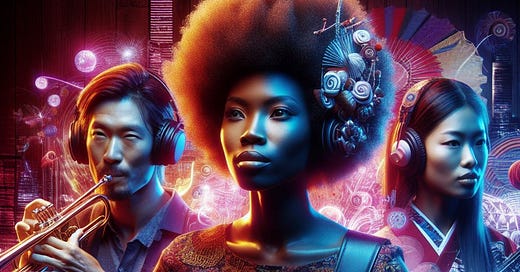I have created a new genre of African music with Japanese fusion, which I will call "Afro-Nippon Fusion." Here are the elements I have chosen for this genre and the reasons behind my choices:
1. Rhythmic foundation: West African polyrhythms, particularly from the Ewe and Akan people of Ghana. These complex, interlocking rhythms provide a strong, danceable base for the music.
2. Melodic instruments: The Japanese koto and shakuhachi. The koto, a 13-stringed zither, offers a unique, plucked sound that can be both delicate and powerful. The shakuhachi, a bamboo flute, contributes haunting, meditative melodies.
3. Harmonic structure: Pentatonic scales, which are common in both African and Japanese music traditions. This shared musical language allows for a seamless blending of the two cultures.
4. Vocals: Call-and-response singing, a staple of many African music styles, combined with the Japanese tradition of Shigin (recitation of poetry). This fusion creates a dynamic, engaging vocal texture.
Here is an example of an "Afro-Nippon Fusion" song in ABC notation:
```
X:1
T:Afro-Nippon Fusion Example
M:4/4
L:1/8
Q:1/4=120
K:Dm pentatonic
V:Koto
|:D3E F2G2|A2B2 A2G2|F2G2 A2B2|A6 G2:|
V:Shakuhachi
|:F2A2 G2B2|F2A2 G4|D2F2 E2G2|F6 z2:|
V:Vocals
|:D2 z2 F2 z2|A2 z2 G2 z2|F2 z2 A2 z2|D6 z2:|
w:Call: Hey-ya, hey-ya
w:Response: Hey-ya, hey-ya
w:Call: O-hanami, sakura
w:Response: Yoru no utage
```
This example showcases the interlocking rhythms of the koto and shakuhachi, the call-and-response vocals, and the shared pentatonic scale. The lyrics incorporate both African vocables (e.g., "hey-ya") and Japanese words related to cherry blossom viewing (hanami) and nighttime festivities (yoru no usage).
The fusion of African and Japanese musical elements creates a unique, captivating sound that celebrates the rich musical traditions of both cultures while forging a new, innovative genre.



